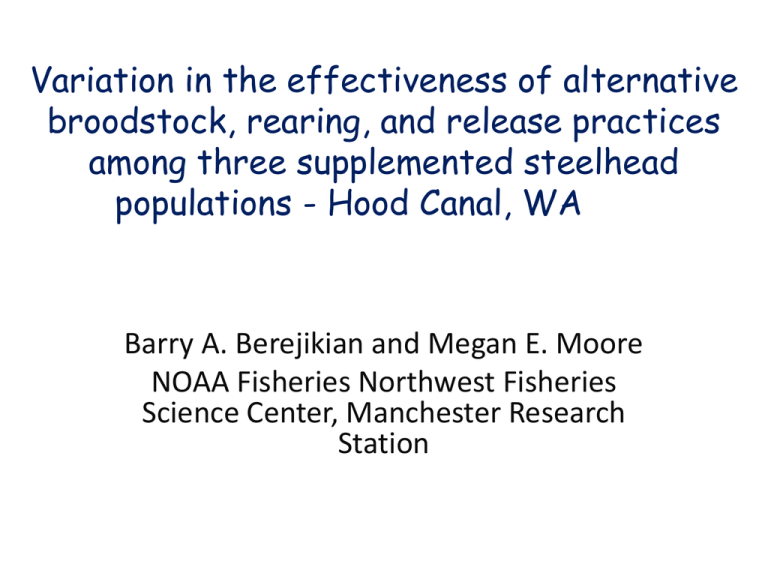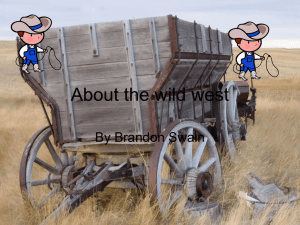Berejikian_and_Moore_Pt_Townsend
advertisement

Variation in the effectiveness of alternative broodstock, rearing, and release practices among three supplemented steelhead populations - Hood Canal, WA Barry A. Berejikian and Megan E. Moore NOAA Fisheries Northwest Fisheries Science Center, Manchester Research Station Acknowledgements • • • • • • • • • NWFSC Behavioral Ecology Team Long Live the Kings Hood Canal Salmon Enhancement Group Washington Department of Fish and Wildlife US Fish and Wildlife Service US Forest Service Hood Canal Private Landowners Skokomish Tribe Point No Point Treaty Tribes Hatchery experiment • Replicated, before-during-after-control-impact experiment (RBACI) • Response variables = •spawner abundance and spawn timing, •freshwater productivity (egg to smolt) •life history diversity •genetic variation •Other stuff (C) Hood Canal stream habitat and population traits Proportion of redds Standardized streamflow 2.0 1.5 1.0 0.5 0.0 -0.5 0.50 Kitsap 0.40 Olympic 0.30 0.20 0.10 0.00 -1.0 -1.5 18.0 16.0 14.0 12.0 10.0 8.0 6.0 4.0 2.0 L. Quilcene Hamma Tahuya Big Beef Duckabush SF Skokomish Dewatto Cumulative proportion Temperature (C) -2.0 1 0.9 0.8 0.7 0.6 0.5 0.4 0.3 0.2 0.1 0 ~April 25 ~May 7 70 80 90 100 110 120 130 140 150 160 170 180 Calendar day Domestication selection in steelhead hatcheries • Ha: Fitness loss caused by a. Selection for rapid growth rates and correlated traits (vis. Berejikian et al. 1996, Reisenbichler et al. 2004, Araki et al. 2008) b. Artificial breeding • Potential solutions: Avoid artificial breeding and rear to modal age-atsmoltification 16% 14% 12% 10% 8% 6% 4% 2% 0% 1 YR 2 YR 85-89 105-109 125-129 145-149 165-169 185-189 205-209 225-229 245-249 265-269 285-289 305-309 • Problem: Late/spring spawn timing of wild steelhead precludes age-1 smolt rearing without inducing size selection after release Age-at-smoltification in Hood Canal steelhead populations Ageing: WDFW ageing laboratory Hood Canal steelhead hatcheries LLTK Lilliwaup Hatchery ( C) Hamma Hamma Duckabush Dewatto Release: Age-2 smolts Age-4 and -5 adults WDFW McKernan Hatchery SF Skokomish Variation in egg collections Eggs collected/goal 1.20 1.00 0.80 0.60 0.40 0.20 Hamma Hamma Hamma Duckabush Duckabush Skokomish Skokomish Dewatto Dewatto 0.00 2007 2008 2007 2008 2007 2008 1998 1999 2000 Proportion naturally viable to Ponding 1.00 0.80 0.60 0.40 0.20 Hamma Hamma Hamma Duckabush Duckabush Skokomish Skokomish Dewatto 0.00 Dewatto Proportion of viable eggs 1.20 2007 2008 2007 2008 2007 2008 1998 1999 2000 Egg collection and release numbers Number of fish released River Dewatto Dewatto Dewatto Dewatto Dewatto Brood Year Redds 2007 16 2008 24 2009 9 2010 7 2011 20 Eggs collected 9,438 9,327 9,171 5,861 7,276 Duckabush Duckabush Duckabush Duckabush Duckabush 2007 2008 2009 2010 2011 6 8 1 6 9 3,020 6,288 44 3,149 4,756 Skokomish Skokomish Skokomish Skokomish Skokomish 2007 2008 2009 2010 2011 39 50 44 41 35,290 34,813 29,952 29,712 Age-1 0 0 0 51 Age-2 7,375 6,807 6,571 Age-4 226 Age-5 24 0 0 0 140 1,574 4,671 0 164 45 4,091 23,747 200 20,529 0 26,642 0 54 Total released 7,601 6,807 6,571 51 1,738 4,671 0 140 27,892 20,729 26,642 0 Smolt size Dewatto Duckabush Skokomish 2009 2010 2011 250 200 150 100 50 0 McKernan Hatchery Lilliwaup Hatchery 200 180 May 200 Duckabush be show individual population 160 Body weight (g) Body weight (g) 160 140 120 100 80 60 40 180 Body weight (g) 160 140 120 100 80 60 40 20 0 120 100 80 60 20 0 200 140 40 20 0 Dewatto Skokomish 180trajectories growth Smolt quality Skokomish 1.00 0.80 1 2 3 M 0.60 0.40 0.20 0.00 2009 2010 2011 Smolt index is significantly correlated with early marine survival (Moore et al. in prep) Acoustic Telemetry Photo by Teresa Sjostrom Moore et al. in review Big Beef (Wild) Hamma (L-Hatch) Big Beef (Wild) Big Beef (Wild) Skokomish (Wild) Skokomish (Mc-Hatch) Big Beef (Wild) Duckabush (L-Hatch) Skokomish (Wild) Skokomish (Mc-Hatch) Big Beef (Wild) Skokomish (Wild) Skokomish (Mc-Hatch) Percent survival Early marine survival (release to Hood Canal Bridge) 120 PR-RM (FW) 100 RM-HCB 80 60 40 20 0 2006 2006 2007 2008 2008 2008 2009 2009 2009 2009 2010 2010 2010 Moore et al. 2010 and Moore et al. in prep Why differences in smolt quality? Lilliwaup Hatchery (Duckabush & Dewatto) McKernan Hatchery (Skokomish) 8.9º C 8.6 º C Feed Manufacturer Bio-Oregon Bio-Oregon Feeding frequency 3x/d, 4 days/wk 2-3x/d, 7 days/wk Mean density index (to age-1) 0.0066 0.290 Mean density index (age-1 to age-2) 0.0065 0.056 Vessel size/shape (to age-1) 10’ circular 16’ circular Vessel size/shape (age-1 to age-2) 20’ circular 12 x 140’ raceway 2 1 Mean water temperature # of size sorts (to age-1) Spawner abundance estimates 450 First year of hatchery spawners 400 Abundance estimate 350 300 Control streams 250 Duckabush 200 Dewatto 150 SF Skokomish 100 50 0 2007 2008 2009 2010 2011 Summary • Juvenile steelhead rearing regimes can be modified to match modal age-at-smoltification and natural smolt size • Smolt quality and precocial male maturation can vary substantially between hatcheries even under the same protocols • Rearing density may warrant a closer look • Simple metrics for smolt quality correspond to early marine survival estimates Extra Stuff Follows Berejikian et al. 2011b. Env. Biol. Fish. Early marine survival PR-RM (FW) RM-HCB April 15, 2013 312 2811 Skokomish (Mc-Hatch) June 6, 2012 Skokomish (Wild) April 1, 2012 Skokomish (Mc-Hatch) 3630 Skokomish (Wild) 403 Skokomish (Mc-Hatch) April 15, 2013 Skokomish (Wild) March 7, 2012 Big Beef Creek January 1, 2012 Duckabush (L-Hatch) Rearing TU Big Beef (Wild) Rearing days Big Beef (Wild) Release Big Beef (Wild) Emergence Hamma (L-Hatch) Spawning Big Beef (Wild) Percent survival 100 90 80 70 60 50 Population 40 30 Traditional 20 10 Wild 0 2006 2006 2007 2008 2009 2009 2010 2008 2008 2009 2009 2010 2010






